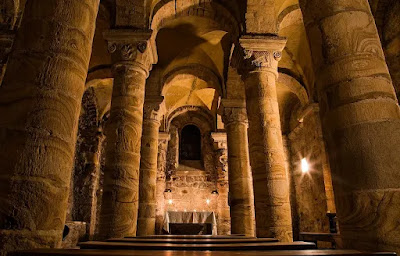To be truly effective, a good narcotics agent should know and love narcotics. Similarly, a good DM should know and love dungeons.
Today I went to the Norman Chapel at Durham Castle, a subterranean place of worship built around 1080. It was packed with sightseers (Durham Castle isn't normally open to visitors) and, because it was cold and wet outside, the air within was full of that distinctive warm, slightly foetid smell that seems to arise in an encolosed space in which there are a lot of people who have just stepped in from the rain. My eldest said it smelled like the reptile house at the zoo; I thought it smelled like my old classroom at school on what we used to call a 'wet lunch' when we weren't allowed outside at lunch hour because it was too inclement.
But it retained its ability to impress. It is not a large space - I would estimate something like 10 x 10 metres if that. And it was empty of the paraphernalia that must have once been in there: pews, candles, altars, etc. Yet there was a lot going on in it all the same. There are a lot of columns, none of which are identical, and all of which are decorated with interesting symblic carvings at the top (including a mermaid, leopards, hunting dioramas, and so on):
But it doesn't quite convey just how cramped it is. There's barely room to swing a cat, let alone a sword, and there is everywhere something to duck or hide behind. It gives the '1 minute combat round' a whole other aspect to imagine how hard it would be to actually land a telling blow in a fight in such circumstances, considerations of armour set aside.
More crudely, the room makes a very good case for the column. Like most DMs, the rooms in my dungeons tend to lack columns unless I feel it would be interesting to include them or they had some aesthetic or other purpose. But, of course, 'real life' dungeons would be full of columns. This makes the column a much neglected phenomenon in OSR writings. How to make columns interesting ought to be a subject to which we have devoted large amounts of time and generated much theoretical insight. Courtney Campbell, Melan/Gabor Lux, Prince of Nothing, Ktrey Parker - we are looking at you.



Did you search for secret doors?
ReplyDeleteI didn't. The reptile-house smell put off the kids so we went and watched some medieval re-enactors staging a melee.
DeleteThe scale (relative and absolute) of the column is going to affect things heavily - there's a big difference between the Norman Chapel, and a much larger but kind of just scaled up space like a storm drain reservoir (e.g. the one people share pictures of in Japan, or there's a similar underground one, but much older, in Liverpool), where between the columns is a large space, but each column effectively hides a large area from view. And of course, what is a forest but a set of less regular columns?
ReplyDeleteTrue!
DeleteIn terms of interesting columns, we do have Roger G-S's Caryatid Cordon from the Baroque spell book.
ReplyDeletehttps://rolesrules.blogspot.com/2012/10/folio-spells-caryatid-cordon-of-cerysse.html
We do indeed - thanks for this.
DeleteI'm struck by how many fantasy dungeons have little to nothing by way of decor, carvings, etc. If this is mentioned at all, it's often in a passing reference. Granted no one wants to read through (let alone write) a long essay on the intricacies of art embedded in columns, walls, or doors, but I've made up stuff on the fly that speaks a little to the lore of the place the adventurers are in, if it is significant and/or pertinent to the adventure.
ReplyDeleteMaking stuff up on the fly often works best but I also like the idea of quasi-systematising it for when inspiration fails.
DeleteI remember running a published megadungeon that had multiple pages on construction styles & decorations up front, and maybe a paragraph at the start of each level's key - but nothing in the rooms and (almost) nothing on the maps, and so you never were reminded of it in the heat of play. Frustrating; so, now when I augment keys I try to put *some* relevant notes like these inline.
DeleteAbout ten years ago we were going through Hampton Court in England and in the back corner of one of the enormous fireplaces, almost out of sight, was a mousetrap. My wife leaned over and whispered to me "I detect a trap in the fireplace"
ReplyDeleteThat is a classic English stately home moment.
DeleteYou may expect my proposal within the weekend. I have some ideas. Good concept for a post, good challenge.
ReplyDeleteFirst:
ReplyDeletehttps://princeofnothingblogs.wordpress.com/2024/04/15/on-columns-and-their-use/
Nice. I will read and comment over there.
DeletePews were a Protestant innovation, first appearing in the 1500s and not common until the 18th c. Congregations in Medieval churches stood.
ReplyDeleteMind = blown.
DeleteIIRC this is why they could do things like stand around chatting or *holding market* inside the cathedrals: https://en.wikipedia.org/wiki/Paul%27s_walk
DeleteHa, yes.
DeleteOne thing that strikes me is just how easy it would be to hide from others _who are in the same room_!
ReplyDeleteYes - puts a whole new perspective on thief skills.
DeleteTo put forth a counter-point: I was able to visit the ruins of the Crusader citadel in Acre (Akko), Israel. The size and scope of the place is utterly remarkable, and there are narrow passageways and corridors, as well as large open areas where there is plenty of room to swing a sword.
ReplyDelete